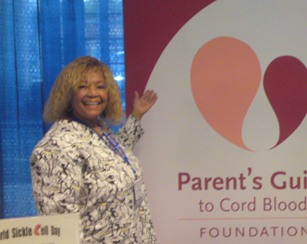Você está aqui
June 19 is World Sickle Cell Day

Sickle Cell Disease (SCD) is a painful, life-threatening illness that affects people of every racial and ethnic background, and is the most frequently occurring genetic disease on Earth. To raise awareness that SCD is global health issue, the United Nations passed a resolution that June 19 is World Sickle Cell Day.
Nita Thompson has dedicated her life to correcting misperceptions and educating the public about SCD. Where normal red blood cells are round, those of SCD patients are deformed with many shaped like a sickle, they are hard and tend to stick together. Clumps of sickle cells can block small blood vessels, causing very painful "crisis" episodes and in severe cases lead to strokes, heart attacks, and death. To combat these symptoms, some SCD patients often need blood transfusions every two, three or four weeks for the rest of their lives!
Healthcare providers especially need to be educated about SCD, says Thompson. When SCD patients in pain crisis go to an emergency room where they are not known by the staff, they may be suspected of drug addiction. One patient was told by medical staff, "You can't have Sickle Cell, you're white". To help spread the word about SCD, Thompson started the group, African American Blood Drive and Bone Marrow Registry 4 Sickle Cell Disease Awareness, or AA4SCDAwareness.
The statistics are that 1 out of 400-500 African American newborns has SCD and 1 out of 1,000-1,400 Hispanic newborns has SCD. Due to high birth rates and under-diagnosis in the community, it is estimated that by 2013, Latinos will exceed African Americans treated in California hospitals for SCD. All US states now screen newborns for SCD. Among adult African Americans, it is known that 1 out of 10-12 is a carrier of the genetic trait for SCD. If both parents are carriers, there is a 1 in 4 chance each offspring will have SCD.
At present, the only cure for SCD is a stem cell transplant to completely replace the patient's immune system. The stem cells may come from either bone marrow or cord blood. However, due to the risks of taking high dose chemotherapy for a transplant, this cure is reserved for the sickest patients, such as children having strokes. Researchers are running clinical trials in an effort to make transplants available to more SCD patients by using Reduced Intensity Chemotherapy (see ClinicalTrials.gov)
The connection between SCD and cord blood is that most African Americans who need stem cell transplants cannot find matching bone marrow donors, and receive transplants of stem cells from cord blood instead. So the efforts to treat SCD patients are intertwined with the need for more cord blood donations from ethnically diverse babies.


